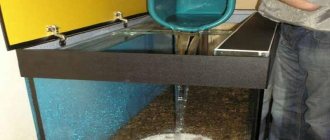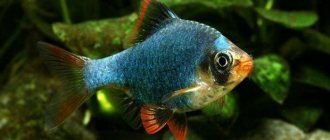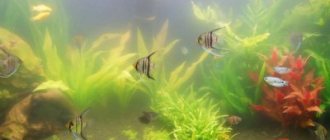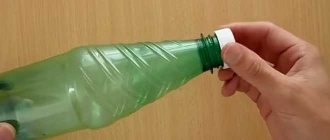Choosing an aquarium
The arrangement begins with the purchase of a glass fish house. Aquariums are sold in different shapes and sizes. The most stable bacterial environment is formed in large tanks, so a spacious aquarium is suitable for dummies. The advantage of such a capacity is also the settlement of a larger number of fish and the ability to breed pets. Give preference to the classic rectangular shape. A spherical or unusually shaped vessel will become a source of stress for the fish.
Installation Requirements
To properly install an aquarium for beginners, an aquarist should adhere to the following rules:
- The tank is installed in a place where there is no direct sunlight, there is no constant noise and movement.
- The surface on which the item is placed must support the weight of the glass reservoir.
- All manipulations with the aquarium (raising the lid, washing the filter or changing the liquid) must be carried out without obstacles.
- Think in advance where the equipment is connected.
Choosing an aquarium for your home
Before purchasing an aquarium, you need to carefully consider its design and shape, allowing it to fit into the interior of the room as naturally as possible without interfering with its main purpose. In addition, it is necessary to place it in a place convenient for viewing.
According to their design, aquariums are available on a stand, on legs, suspended, corner, framed and frameless. In terms of form, they are represented by more than a wide selection, the main of which are:
- spherical (round);
- cubic (square);
- parallelepipedal (rectangular);
- parallelepipedal with convex viewing glass (panoramic);
- prismoidal (with a regular polygon bottom, usually high, for floor installation);
- pyromidoidal (triangular, for closed aquariums).
The main parameters for choosing a container for keeping fish are the following factors:
- correct installation, allowing for various manipulations during operation (removing or installing the lid and lighting, feeding fish, planting plants, cleaning the filter, bottom siphon, etc.);
- exclusion of direct sunlight on its surface;
- the number and size of the population of the aquarium (the required volume of the tank depends on this. If there is no certainty about specific fish, then take at least 1 liter of water per 1 cm of adult fish, i.e. if you want to keep 10 fish 8 cm long, you need an aquarium more than 80 liters, this will avoid overpopulation and allow its inhabitants to develop well and feel comfortable).
Water
Prepare the water before starting. It settles for at least a day; it should not contain chlorine or other harmful impurities. You will need special water tests and a bacterial culture for the first run. Some types of fish need soft or, conversely, hard water. The liquid is softened by boiling or freezing. Water becomes harder due to stones and shells.
Equipment
To keep fish comfortable in an aquarium, purchase the necessary equipment. Equipment providing main functions:
- Internal filter. Suitable for a small aquarium. Filters water, preventing cloudiness and stagnation. Before purchasing, read the instructions, which outline the characteristics of the device and operating rules.
- External filter. External devices are more expensive. Filter the liquid in larger tanks.
- Compressor for saturating water with oxygen. Provides a comfortable existence for the fish.
- Thermometer. Allows you to monitor the temperature.
- Temperature regulator. Heaters with pond coolers are especially useful on hot or cold days.
- Lamp. Plants need lighting more than fish. The light will ensure normal growth of aquarium flora and imitate the natural habitat.
What equipment does an aquarist need:
- siphon for soil purification;
- net;
- feeders for live food;
- scraper for cleaning aquarium glass from algae.
From practical experience
There are some general tips for keeping and breeding fish, but it all depends on the specific inhabitants of your aquarium.
- It is better to purchase a rectangular aquarium without panoramic glass, and its length should be greater than the height and its width less than the height.
- It is not recommended to place the aquarium directly on the stand; there must be a soft lining to smooth out various unevenness. The aquarium itself should stand on a flat, smooth surface and its edges should not protrude beyond the edge of the cabinet, otherwise the glass may become deformed or even crack.
- Round spherical vases are not suitable for keeping aquarium inhabitants. It is impossible to install the necessary equipment in them, and the fish themselves will be under constant stress from the light refracted due to the curved walls.
- An aquarium volume of about 100 liters will allow it to maintain a closed ecosystem (the state of the water in temperature, chemical and biological ranges will be less subject to sudden changes, which will affect the well-being of the fish), and will also require less effort for maintenance.
- Maintaining a constant temperature will relieve fish from many diseases.
- You cannot overfeed your fish, but it is better to feed them once a day. The food should be varied - live, frozen, dry (if you feed it constantly dry, the fish may develop obesity and vitamin deficiency, which negatively affect reproductive function).
- Water changes in the aquarium should be weekly, replacing up to 30% of the total volume. There is no need to clean and siphon the bottom in the first month after launch. Depending on the number of fish, bottom contamination or water chemical indicators, these activities should be carried out approximately once every two to four weeks.
- The water filter and aerator in the aquarium should work around the clock.
- Lighting must be controlled, otherwise excessive growth of algae or plants will begin, and the fish will be depressed. The duration of illumination per day ranges from 8 to 12 hours.
Experts from the “Cheap and Cheap” program (Channel One) will tell you how to choose an aquarium:
Accessories
Sometimes the glass tank comes complete with cabinets and lids with built-in lighting. This option is useful if there is no space to install the vessel. The cabinet is designed to support the weight of a water container, and there are compartments for storing aquarium accessories. The lid is convenient because it prevents fish from jumping out and relieves the aquarist from the inconvenience associated with installing lighting.
Choosing fish
Start your journey in aquarium keeping with small, unpretentious aquarium fish. Beautiful, unpretentious fish suitable for the role of first aquarium pets:
- viviparous (guppies, platies, swordtails, mollies);
- catfish (Ancistrus, Corydoras);
- zebrafish;
- cardinal;
- lalius.
These fish live in different temperatures and water conditions, making them a must-have for a beginner.
Feeding
Grains of food for the inhabitants of the upper layers of water should not fall to the bottom. Special dry balanced food is sold for different types of fish. Diversify your diet with plant foods and frozen food.
Pets must eat all the food given to them within five minutes.
Treat food with boiling water; for small fish, serve chopped food. Large aquarium inhabitants are given large granules. Feed the fish at the same time, create a diet based on their needs.
Don't overfeed your fish
The main cause of problems for novice aquarists (often even for experienced ones) is too much feeding. An aquarium is a closed environment, so anything that gets into it will become part of the water in which the fish live.
The food ends up in the soil, where it rots, releases toxic phosphates, accelerates the growth of harmful algae, and makes the aquarium look unhealthy. Overfeed the fish and the water will become cloudy, the fish will get sick, and disgusting algae will cover the glass.
How do you know if you are overfeeding your fish? Everything you throw into the aquarium should be eaten within a minute; if the food falls to the bottom or is not eaten within a minute, this is wrong!
The exception to this rule is catfish, they need sinking food, such as tablets, and even if they fall to the bottom, the catfish will quickly destroy them.
In a new aquarium, it is better to feed the fish once a day, but after a while you can increase the amount, following the rule - little by little and often.
Have a fasting day once a week - do not feed the fish, this will allow them to stay healthy and search for food on their own.
Plant selection
It is impossible to provide complete care for an aquarium without aquatic plants. They are important for those who want to get into aquascaping. It is better to choose unpretentious aquarium plants that can live at different temperatures, water parameters, and minimal lighting. Suitable for beginners:
- elodea;
- Vallisneria;
- Riccia floating;
- key, Java moss;
- pinnate;
- Thai ferns, pterygoid;
- Echinodorus Amazonis;
- hornwort.
Avoid self-harvested plants. Before starting, treat purchased plants in an aqueous solution of 3% hydrogen peroxide (1 teaspoon per liter of water) or in a solution of methylene blue (0.5 g per liter of water). Trim the greens periodically, making sure that no dark coating appears on the leaves.
How to properly care for an aquarium
Caring for an aquarium at home is easy - constantly monitor the internal state of the environment. Take your time when cleaning the tank or changing the water. The process requires patience and regularity, as well as some knowledge and experience.
Soil cleaning
The frequency of using the siphon depends on the volume of the aquarium and the conditions of detention. You need to siphon the soil paying attention to each section of the bottom.
During the cleaning process, water flows out along with impurities. The water pressure is regulated by the position of the container into which the dirty water flows. You can combine water changes with soil cleaning. Before siphoning, turn off the aquarium equipment. Remove decorations and wash them separately.
Cleaning the filter
All filter elements are washed with aquarium water. Rinsing under running water will destroy colonies of beneficial bacteria. It is recommended to change the filter material every six months.
Water change
Maintaining an aquarium at home involves partial water changes once a week. Under no circumstances should the water be completely replaced with fresh water. The amount of new water should not exceed 25%. Sudden changes in temperature and biochemical composition of water are harmful to fish. Changes are made with clean, settled water.
Pros and cons of different types of aquariums
Aquarium made of plexiglass (acrylic glass).
Complex plexiglass). The wall-mounted aquarium in the military unit is made from half a blister from a Tu-16 bomber. Photos from open sources.
Advantages:
1) Impact resistance
2) The seam is difficult to damage
3) Relatively light
4) Can be installed on a not very flat surface
5) Has low thermal conductivity - maintains water temperature longer.
6) The material allows you to create aquariums of any configuration and almost unlimited sizes.
7) Makes it possible to easily drill new holes even in a finished product.
Flaws:
1) Easily scratched both outside and inside. Because of this, it requires polishing from time to time.
2) Requires special soft materials to clean the surface.
3) Over time, it acquires a yellowish tint.
4) To impart rigidity, a greater wall thickness is needed than a glass aquarium of the same dimensions.
5) Expensive material, as a result, the high price of the aquarium.
Rules for aquarists
Tips for beginner aquarists:
- Watch the behavior and appearance of the fish. The color should be rich, the eyes should not be cloudy. If you have any suspicions, contact experienced aquarists, describing in detail the problem, the parameters of the aquarium and the features of keeping the fish.
- Keep in mind that even in a healthy aquarium, in addition to plants and fish, other small inhabitants appear (for example, ciliates or small insects).
- Maintain your aquarium on time. Incomplete care of the aquarium stimulates fish poisoning and decreased immunity.
- When introducing new fish, study information about them. They may be incompatible in terms of required water parameters or temperament.
- If the fish dies, immediately remove the corpse from the water. Determine the cause of death by external examination.
- If the fish shows signs of illness, place it in a separate container.
- Do not knock on the glass or interfere with the life of the inhabitants of your home aquarium unless necessary.
- When you start breeding fish, learn what you can’t do without for successful spawning, and how many males a female is placed with.
- To avoid damaging the walls of the aquarium, use a non-metallic scraper.
- If stones are collected from the street, test them for the presence of heavy metal ions with acetic or citric acid. Stones containing undesirable elements will react when they come into contact with acid. Boil the soil thoroughly to avoid introducing parasites into the aquarium. Driftwood collected from nature must also be thoroughly boiled.
- To prevent fish from jumping out of the aquarium, cover the container with a lid.
- Proper use of an aquarium siphon, connecting equipment or feeding fish is impossible without training and preparation, it will take a little patience before the aquarium hobby becomes productive.
Science points to fish's ability to sense and recognize faces. Aquatic pets have their own characteristics and range of sensations. Don’t be lazy to create comfort in the world of underwater inhabitants, because fish are sensitive and intelligent creatures.
Previous Aquarium Daily feeding using feeders for aquarium fish Next
AquariumIs it enough for an aquarium to sit for just a few hours?
Aquarium - where to start breeding fish at home
Breeding fish in an aquarium is a hobby for millions of people. Both adults and children enjoy watching living creatures of unique beauty splashing in the water. Do you love nature and animals, but don't know which pet is right for you? Get an aquarium. Caring for fish is simple and does not require much time. And watching the movement of a colorful flock will bring many interesting and pleasant minutes. The question that a beginner asks himself when he decides to start an aquarium is where to start? The first step is to familiarize yourself with the general recommendations to decide whether this hobby is right for you.
- What a beginner aquarist needs
- Launching an aquarium: secrets of mastery
- What kind of fish should a beginner get?
- How to care for an aquarium
What a beginner aquarist needs
When buying an aquarium you need to be responsible. If you simply fill it with tap water and add tenants purchased on the same day, you will be greatly disappointed. The water will become cloudy and the fish will most likely die.
An aquarium is a fragile ecosystem. The most important task is to establish balance in it. When the water is clear, the plants are lush and green, and the fish are happy. It is best to start getting acquainted with aquariums by reading literature and communicating on forums of like-minded people. And when you feel that the issue has been sufficiently studied, feel free to go to the pet store.
Aquarium diagram
Pet stores have everything a beginner needs for an aquarium. At the first stage you need to buy:
- Aquarium . Many people think that it is better to buy the smallest one to start with. But this is not true; it is more difficult to establish balance in a small container. Therefore, choose a fish house with a volume of at least 40-50 liters, and preferably more. Stop at the simplest rectangular aquarium - it is easier to care for than a round or shaped one.
- Lighting . Both fish and plants require additional light, especially if the aquarium is located in the back of the room. Usually the lid sold with the aquarium already contains the required minimum of lamps. The best ones are fluorescent lamps and ordinary energy-saving lamps. For a volume of 50 liters, lighting of 25-30 watts is sufficient.
- Filter . In order for the water in your aqua world to remain clean and clear, it must be purified. So your next purchase will be a filter. They are internal and external. For a beginner, it is better to purchase an internal filter. Almost all filters have an aeration system - air from the room is supplied to the water and sprayed there with small bubbles so that the fish have something to breathe.
- Heater and thermometer . Most aquarium fish are thermophilic. To keep your residents from freezing, you need to maintain a temperature in the aquarium of about 22-23 degrees.
- Soil . If you want to admire not only fish, but also lush thickets of aquatic plants, you need to take care of suitable soil. Do not buy a color mixture; poor quality paint can be toxic. The best soil is quartz, basalt, granite with a grain diameter of 2-4 mm. Smaller ones often cake and sour, and in larger ones it will be difficult for plants to take root. Read more about the soil here.
- Net, feeder, siphon . No aquarist can do without these little things.
Decorative elements
Launching an aquarium: secrets of mastery
So, all the equipment has been purchased and is waiting in the wings. The question arises: what about the fish? When will their turn come? There is no need to rush with the fish. Their turn will come only in two to three weeks. In the meantime, we need to start starting the aquarium. Launching is a process during which the balance necessary for the life of fish is established in a container filled with water.
You need to act strictly according to plan:
- Preparing the soil and container. The aquarium needs to be thoroughly washed and rinsed. The soil should also be rinsed several times to remove dust and very small particles. Stones and driftwood to decorate the composition are also washed.
- Creating an underwater landscape. The aquarium is put in place and they begin to conjure to create a beautiful landscape. First, fill the soil with a layer of 4-5 cm, making a slight slope towards the front wall. Then they install decorative elements - pebbles, driftwood, grottoes. Fill in a third of the volume of water.
- Planting an underwater garden. Now it's the turn of the plants. For beginners, unpretentious species are suitable - vallisneria, hornwort, rotala, cryptocorynes, elodea. When planting, proceed as with ordinary land plants. The long roots are lightly trimmed, the bush is buried in the soil and the hole is sprinkled. At first, you can weigh down the bushes with pebbles so that they do not float up.
- Filling water and installing equipment. The work is nearing completion. Water is poured into the aquarium, and then a filter, a heating pad and a thermometer are attached to the glass. The equipment is turned on immediately.
- Balance. Now you need to forget about the aquarium for a while. Yes, yes, you don’t have to worry that the water has become cloudy and the overall composition looks unpresentable. After a week, the water will gradually clear, the plants will straighten their leaves. This will mean that balance is being established in your underwater world. But even now there is no need to rush with the fish. If you really want to, you can throw snails in there and wait another week.
What kind of fish should a beginner get?
In the pet store, your eyes widen from the abundance of fish - big and small, bright and not so bright, nimble and calm. How not to get confused among this splendor and choose those pets that will please the eye and will not require complex care?
It is best to introduce the most unpretentious fish into an aquarium for beginners. Here is an incomplete list of aquarium residents that are undemanding to living conditions:
- Guppy . The most popular fish. Bright males and gray females live in almost any conditions. And with proper care, they will also delight you with offspring.
- Swordtails, platies, mollies . Viviparous fish of bright colors - red, black, yellow.
- Gourami . Beautiful, unpretentious fish with lower fins in the form of long mustaches.
- Barbs . Striped, very active pets. It is better to keep them separately, because many individuals are pugnacious and offend more peaceful fish.
- Catfish . Be sure to get yourself some Corydoras or Ancitrus. It's very interesting to watch them.
- Danio . A cheerful flock of these minke whales will decorate any aquarium.
How to care for an aquarium
Finally, your aquarium is populated with residents. It is not difficult to care for it; it is enough to spend a couple of minutes every day and half an hour to an hour once a week.
The fish are fed daily. If you do this every time at a certain time, they will soon get used to the regime and will swim to the feeder in anticipation of a meal. There is a lot of ready-made dry food in stores, but it is still better if you can feed the fish with live food - daphnia, bloodworms, tubifex. You can buy live food at bird markets or arm yourself with a net, walk along nearby bodies of water and get the food yourself.
On weekends, it’s time for more thorough care of the aquarium. You will have to replace some of the water, remove debris from the bottom, rinse the filter, and clean the glass. Water for replacement must first be settled. Approximately 15-20% of the total volume is changed. For example, if your aquarium holds 50 liters, then replace 7-10 liters of water.
Aquariums often become a lifelong hobby, because creating underwater worlds brings peace and tranquility to a busy life. This hobby is much more interesting and useful than fishing.
Author: Kirichek Oksana, especially for the online magazine Women's Hobbies.











